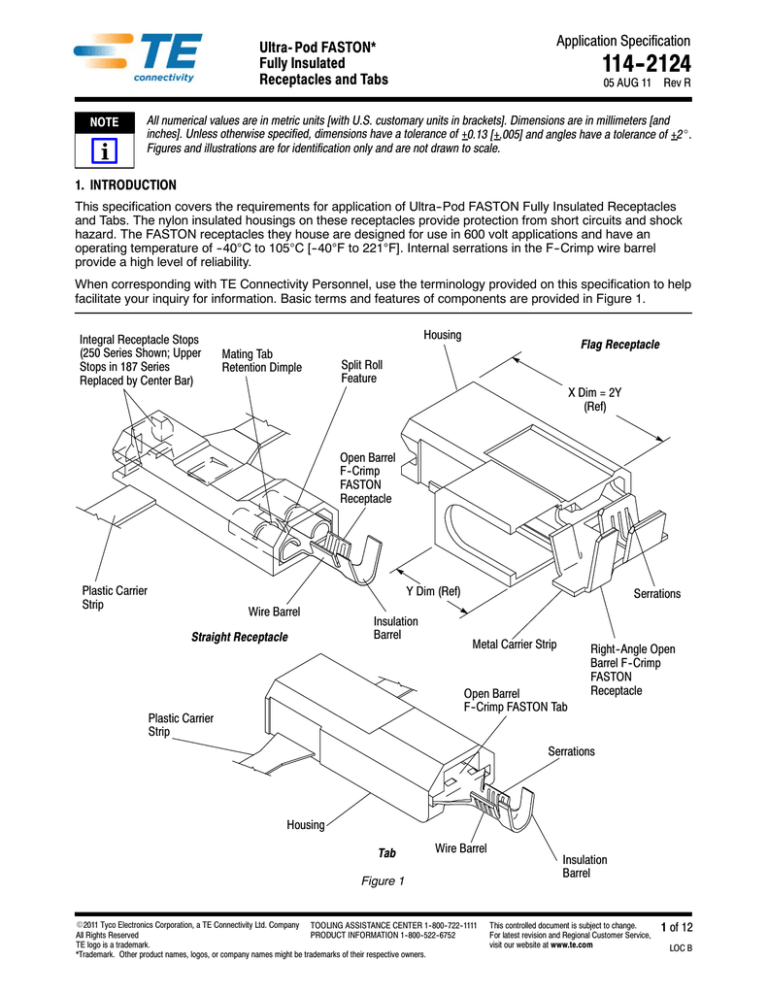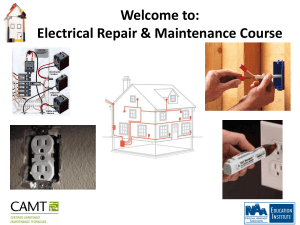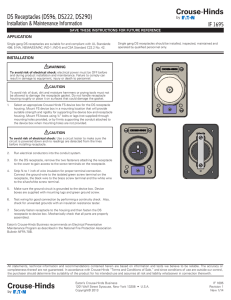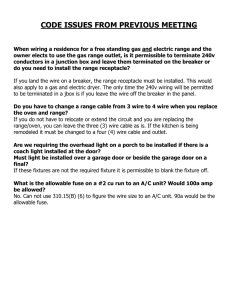
Application Specification
Ultra- Pod FASTON*
Fully Insulated
Receptacles and Tabs
NOTE
i
114-- 2124
05 AUG 11 Rev R
All numerical values are in metric units [with U.S. customary units in brackets]. Dimensions are in millimeters [and
inches]. Unless otherwise specified, dimensions have a tolerance of +0.13 [+.005] and angles have a tolerance of +2_.
Figures and illustrations are for identification only and are not drawn to scale.
1. INTRODUCTION
This specification covers the requirements for application of Ultra--Pod FASTON Fully Insulated Receptacles
and Tabs. The nylon insulated housings on these receptacles provide protection from short circuits and shock
hazard. The FASTON receptacles they house are designed for use in 600 volt applications and have an
operating temperature of --40C to 105C [--40F to 221F]. Internal serrations in the F--Crimp wire barrel
provide a high level of reliability.
When corresponding with TE Connectivity Personnel, use the terminology provided on this specification to help
facilitate your inquiry for information. Basic terms and features of components are provided in Figure 1.
Integral Receptacle Stops
(250 Series Shown; Upper
Stops in 187 Series
Replaced by Center Bar)
Housing
Mating Tab
Retention Dimple
Flag Receptacle
Split Roll
Feature
X Dim = 2Y
(Ref)
Open Barrel
F-- Crimp
FASTON
Receptacle
Plastic Carrier
Strip
Y Dim (Ref)
Wire Barrel
Straight Receptacle
Insulation
Barrel
Serrations
Metal Carrier Strip
Open Barrel
F-- Crimp FASTON Tab
Plastic Carrier
Strip
Right-- Angle Open
Barrel F-- Crimp
FASTON
Receptacle
Serrations
Housing
Tab
Wire Barrel
Figure 1
E2011 Tyco Electronics Corporation, a TE Connectivity Ltd. Company TOOLING ASSISTANCE CENTER 1--800--722--1111
All Rights Reserved
PRODUCT INFORMATION 1--800--522--6752
TE logo is a trademark.
*Trademark. Other product names, logos, or company names might be trademarks of their respective owners.
Insulation
Barrel
This controlled document is subject to change.
For latest revision and Regional Customer Service,
visit our website at www.te.com
1 of 12
LOC B
114- 2124
2. REFERENCE MATERIAL
2.1. Revision Summary
This paragraph is reserved for a revision summary covering the most recent additions and changes made to
this specification which include the following:
S Updated document to corporate requirements
S Added new text to Section 1
2.2. Customer Assistance
Reference Part Number 520963 and Product Code 7112 are representative numbers of Ultra--Pod FASTON
Fully Insulated Receptacles and Tabs. Use of these numbers will identify the product line and expedite your
inquiries through a service network established to help you obtain product and tooling information. Such
information can be obtained through a local TE Representative or, after purchase, by calling the Tooling
Assistance Center or the TE Product Information number at the bottom of page 1.
2.3. Drawings
Customer Drawings for specific products are available from the responsible Engineering department via the
service network (see Paragraph 2.2). The information contained in Customer Drawings takes priority if there is
a conflict with this document or with any other technical documentation supplied by TE.
2.4. Specifications
Product Specification 108--1285 covers test data and performance requirements.
2.5. Instructional Material
The following is a list of Instructional Documents (408 Series) that provide assembly procedures for product,
operation, maintenance and repair of tooling, as well as setup and operation procedures of applicators; and
Machine Customer Manuals (409 Series) that provides setup, operation, and maintenance of machines. Refer
to Figure 9 for a complete listing of application equipment and related documents.
Document Number
408--3295
408--7424
408--8053
408--8095
408--8098
408--8099
408--8102
408--9640
408--9725
408--9726
408--9727
408--9816
409--5842
Document Title
Preparing Reel of Contacts for Application Tooling
Checking Terminal Crimp Height or Gaging Die Closure
Conversion Guide For Miniature Quick--Change Applicators
Miniature Quick--Change Applicators 852293--[ ] and 853358--[ ]
Installation Sheet for Ultra--Pod Miniature Quick Change Applicators
Heavy Duty Miniature Quick--Change Applicator 852500--[ ]
Installation Sheet for Quick--Change Applicator 852500--[ ]
Crimp Quality Monitor Applicator for Side--Feed and End--Feed Applications
250 Series Straight Manual Insertion Tool
250 Series Straight and Flag Manual Extraction Tool
250 Series Flag Manual Insertion Tool
Handling of Reeled Products
AMP--O--LECTRIC* Model “G” Terminating Machine 354500--[ ]
3. REQUIREMENTS
3.1. Storage
A. Ultraviolet Light
Prolonged exposure to ultraviolet light will attack and break down the nylon used in the receptacle housing.
B. Reel Storage
When using reeled contacts, store coil wound reels horizontally and traverse wound reels vertically.
C. Shelf Life
The contacts should remain in the shipping containers until ready for use to prevent deformation to the
contacts. The contacts should be used on a first in, first out basis to avoid storage contamination that
could adversely affect signal transmissions.
2 of 12
Rev R
114- 2124
D. Chemical Exposure
Do not store contacts near any chemicals listed below, as stress corrosion cracking may occur.
Alkalies
Ammonia
Citrates
Phosphates Citrates
Sulfur Compounds
Amines
Carbonates
Nitrites
Sulfur Nitrites
Tartrates
Where the above environmental conditions exist, phosphor--bronze contacts are recommended instead of brass if
available.
NOTE
i
3.2. Wire and Receptacle Selection
A. Receptacle Selection
The basic criteria for choosing a receptacle are the width (Series) and the thickness of the tab it is to mate
with. Contact your local TE Representative for information regarding currently available receptacle
choices.
B. Wire Selection
Ultra--Pod FASTON Fully Insulated Receptacles and Tabs will accept wires with insulation ranges as listed
below.
250 Series Straight Receptacle . . . . . . . . . . 2.29--4.57 mm [.090--.180 in.]
250 Series Flag Receptacle . . . . . . . . . . . . . 1.27--4.06 mm [.050--.160 in.]
250 Series Tab . . . . . . . . . . . . . . . . . . . . . . . . 3.30--5.08 mm [.130--.200 in.]
187 Series Straight Receptacle . . . . . . . . . . 2.29--3.30 mm [.090--.130 in.]
187 Series Flag Receptacle . . . . . . . . . . . . . 1.52--3.30 mm [.060--.130 in.]
110 Series Straight Receptacle . . . . . . . . . . 2.03--3.05 mm [.080--.120 in.]
For a more specific listing of wire insulation ranges categorized by terminal type, size and wire applied, refer to the
table in Figure 3.
NOTE
i
3.3. Wire Preparation
Strip the wire insulation according to the dimension provided in Figure 2.
CAUTION
DO NOT nick, scrape or cut the wire conductor during the stripping operation.
!
TERMINAL SERIES NUMBER
250 Straight Receptacle
250
50 Flag
ag Receptacle
eceptac e
WIRE SIZE RANGE (AWG)
22--18
18--14
(2) 18
14--10
22--18
18--14
STRIP LENGTH +0.38 [+.015]
5 72 [.225]
5.72
[ 225]
6.10 [.240]
6.35 [.250]
7 14 [.281]
7.14
[ 281]
(2) 18
7.50 [.295)
250 Tab
18--14
12--10
5 72 [.225]
5.72
[ 225]
187 Straight Receptacle
20--16
(2) 18
4.7 [.185]
5.10 [.200]
187 Flag Receptacle
22--18
(2) 18
5.60 [.220]
6.00 [.235]
110 Straight Receptacle
22--18
4.32 [.170]
Figure 2
Rev R
3 of 12
114- 2124
3.4. Crimped Terminal Requirements
Locate the terminal to be crimped in the appropriate tooling according to the instructions packaged with that
tooling. See Section 5, TOOLING. Perform the crimping operation. Figure 3 shows typical terminals as they
should appear after crimping. The table included in Figure 3 lists proper crimp dimensions and tensile
strengths, arranged by terminal type and wire criteria.
CAUTION
!
NOTE
Terminal insulation shall NOT be cut or broken during the crimping operation. Exercise of reasonable care by tooling
operators should be sufficient to provide undamaged terminations. Damaged terminals should not be used. If a
damaged product is evident, it should be cut from the wire and replaced with a new one.
Periodic inspections must be made to ensure crimped contact formation is consistent as shown in Figure 3.
i
A. Crimp Height
The crimp applied to the wire portion of the terminal is the most compressed area and is most critical in
ensuring optimum electrical and mechanical performance of the crimped terminal. The crimp height must
be within the dimensions provided in Figure 3.
B. Crimp Length
For optimum crimp effectiveness, the crimp must be within the area shown. Effective crimp length shall be
defined as that portion of the wire barrel, excluding bellmouth(s), fully formed by the crimping tool.
Instructions for adjusting, repairing, and inspecting tools are packaged with the tools. See Section 5,
TOOLING.
NOTE
The effective crimp length is given for tooling design only, and should not be used for inspection criteria.
i
C. Bellmouths
Front and rear bellmouths shall be evident and conform to the dimensions given in Figure 3.
D. Cutoff Tab
The cutoff tab shall be cut to the dimensions shown in Figure 3.
E. Burrs
The cutoff burr shall not exceed the dimensions shown in Figure 3.
F. Wire Barrel Flash
The wire barrel flash shall not exceed the dimensions shown in Figure 3 in Section X--X and Y--Y.
G. Wire Location
After crimping, the wire conductor and insulation must be visible in the transition area between the wire
and insulation barrels.
H. Conductor Location
The conductor may extend beyond the wire barrel to the maximum shown in Figure 3.
I. Wire Barrel Seam
The wire barrel seam must be closed with no evidence of loose wire strands visible in the seam.
J. Twist and Roll
There shall be no twist, roll, deformation, or other damage to the mating portion of the crimped contact
that will prevent proper mating.
4 of 12
Rev R
114- 2124
Flush To
0.76 [.030]
Conductor Location
0.25 [.010] Max
Cutoff Tab
(2 Places)
Wire Conductors and Insulation
Must Both Be Visible In This Area
Wire Barrel Seam Closed
With No Conductor Strands Showing
Effective Crimp
Length
Crimp Width
At Tangent
(See Table)
0.89 [ .035 ]
0.38 .015
Rear Bellmouth
0.64 [.025] Max
Front Bellmouth
X
X
Straight Receptacle Shown,
Tab Dimensions the Same
Crimp Height
(See Table)
0.13 [.005]
Max Wire
Barrel Flash
Section X- X
Front Carrier Cutoff
Flush To 0.38 [.015]
Undercut
Wire Conductors and
Insulation Must Both
Be Visible In This Area
Cutoff Tab
1.52 [.060] Max
Conductor Location
Wire Barrel Seam Closed With
No Conductor Strands Showing
Effective Crimp
Length
0.64 [ .025 ]
.015
0.38
Rear Bellmouth
Flag Receptacle
Crimp Width
At Tangent
(See Table)
0.64 [.025] Max
Front Bellmouth
Y
Y
0.38 [.015] Max Rear
Carrier Cutoff Tab With
0.08 [.003] Max Burr (Ref)
Crimp Height
(See Table)
0.25 [.010]
Max Wire
Barrel Flash
Section Y- Y
Figure 3 (cont’d)
Rev R
5 of 12
114- 2124
TERMINAL
WIRE SIZE
RANGE,
AWG
INSULATION
DIAMETER
HEIGHT
+0.05 [+.002]
MINIMUM
TENSILE
STRENGTH
(NEWTONS [LBS])
2.29 [.090]
1.24 [.049]
1.3 [.051]
1.42 [.056]
1.45 [.057]
1.37 [.054]
35.6 [8]
57.8 [13]
89 [20]
35.6 [8]
35.6 [8]
2.799 [[.110]
0]
1.47 [.058]
1.63 [.064]
1.85 [.073]
1.57 [.062]
1.63 [.064]
1.73 [.068]
1.55 [.061]
1.78 [.070]
1.75 [.069]
89 [20]
133.4 [30]
222.4 [50]
35.6 [8]
57.8 [13]
89 [20]
57.8 [13]
57.8 [13]
35.6 [8]
3 3 [.130]
3.3
[ 130]
2.06 [.081]
2.36 [.093]
2.39 [.094]
2.92 [.115]
222.4 [50]
311.4 [70]
133.4 [30]
355.8 [80]
2 03 [.080]
2.03
[ 080]
1.19 [.047]
1.27 [.050]
1.32 [.052]
1.40 [.055]
35.6 [8]
57.8 [13]
35.6 [8]
89 [20]
2.79 [.110]
1.4 [.055]
1.55 [.061]
1.78 [.070]
1.65 [.065]
1.47 [.058]
89 [20]
133.4 [30]
222.4 [50]
89 [20]
57.8 [13]
1.47 [.058]
1.63 [.064]
1.85 [.073]
1.73 [.068]
89 [20]
133.4 [30]
222.4 [50]
89 [20]
1.24 [.049]
1.35 [.053]
1.52 [.060]
1.52 [.060]
1.42 [.056]
1.47 [.058]
1.3 [.051]
1.37 [.054]
57.8 [13]
89 [20]
133.4 [30]
57.8 [13]
57.8 [13]
35.6 [8]
35.6 [8]
35.6 [8]
WIRE APPLIED
QTY
WIRE BARREL CRIMP
WIRE SIZE
(AWG)
WIDTH
(REF)
250 SERIES STRAIGHT RECEPTACLES
22--18
22
18
18--14
8
14 10
14--10
22.29--3.3
29 3 3
[[.090--.130]
090-- 130]
1
1
1
1 ea
2
22
20
18
22, 20
22
3 05 4 32
3.05--4.32
[[.120--.170]
120-- 170]
1
1
1
1 ea
1 ea
2
2
1 ea
1 ea
18
16
14
22, 18
20, 18
18
20
20, 16
22, 16
3.30--4.57
3.30
4.57
[.130--.180]
1
1
1 ea
1
14
12
16, 14
10
250 SERIES FLAG RECEPTACLES
22 18
22--18
1.27 2.54
1.27--2.54
[.050--.100]
18--14
18
14
2.79--4.06
2 79 4 06
[ 110-- 160]
[.110--.160]
(2) 18
(2) 20
(2) 2.67 [.105] Max
(2) 2.67 [.105] Max
1
1
2
1
22
20
22
18
1
1
1
2
2
18
16
14
18
20
250 SERIES TABS
18 14
18--14
3.30--4.57
3.30
4.57
[.130--.180]
1
1
1
2
18
16
14
18
2 79 [.110]
2.79
[ 110]
187 SERIES STRAIGHT RECEPTACLES
20 16
20--16
2.29--3.3
2.29
3.3
[.090--.130]
1
1
1
1 ea
2
1 ea
2
1 ea
20
18
16
20, 18
20
22, 18
22
22, 20
2 29 [.090]
2.29
[ 090]
Figure 3 (cont’d)
6 of 12
Rev R
114- 2124
TERMINAL
WIRE SIZE
RANGE,
AWG
INSULATION
DIAMETER
18 16
18--16
2.67--5.33
2.67
5.33
[.105--.210]
(2) 18
(2) 20
(2) 2.67 [.105] Max
(2) 2.67 [.105] Max
WIRE APPLIED
22--18
22
18
18--14
8
2 67 3 56
2.67--3.56
[[.105--.140]
105-- 140]
(2) 18
(2) 2.67 [.105] Max
WIDTH
(REF)
187 SERIES STRAIGHT RECEPTACLES
1
18
1
16
2 79 [.110]
2.79
[ 110]
2
18
2
20
1
1
1
1
1.50--2.80
1 50 2 80
[ 060-- 110]
[.060--.110]
WIRE SIZE
(AWG)
QTY
187 SERIES FLAG RECEPTACLES
22
20
1.78 [.070]
18
18
1
1
2
16
14
18
HEIGHT
+0.05 [+.002]
MINIMUM
TENSILE
STRENGTH
(NEWTONS [LBS])
1.35 [.053]
1.50 [.059]
89 [20]
133.4 [30]
1.60 [.063]
1.42 [.056]
89 [20]
57.8 [13]
1.09 [.043]
1.19 [.047]
1.32 [.052]
1.27 [.050]
35.6 [8]
57.8 [13]
89 [20]
89 [20]
1.42 [.056]
1.65 [.065]
1.52 [.060]
133.4 [30]
222.4 [50]
89 [20]
1.02 [.040]
1.09 [.043]
1.24 [.049]
35.6 [8]
57.8 [13]
89 [20]
WIRE BARREL CRIMP
2 79 [.110]
2.79
[ 110]
110 SERIES STRAIGHT RECEPTACLES
22--188
2.03--3.05
2 03 3 05
[ 080-- 120]
[.080--.120]
1
1
1
22
20
18
1.57
5 [.062]
[ 06 ]
Figure 3 (end)
3.5. Terminal Alignment and Housing Retention
A. Terminal Alignment
The crimped terminal shall not be deformed or damaged in a manner preventing full insertion into its
housing. There shall be no twist or roll in the contact portion of the terminal that will prevent it from mating
properly.
B. Housing Retention
Terminals must be straight within the limits shown in Figure 4. When seated in housing, the terminal must
bottom against insertion stops. Test for proper seating by pulling lightly in a direction opposite insertion.
10_ Max
Straightness of Terminals
Prior to Pod Insertion
Straight
Receptacle or Tab
3_ Max
Flag
Receptacle
90_
Max
85_
Min
Figure 4
Rev R
7 of 12
114- 2124
3.6. Mating Tab Dimensions
Figure 5 shows features and dimensional requirements for tab terminals intended for mating with Ultra--Pod
FASTON Fully Insulated Receptacles.
Q Min,
Tab
Without
Shoulders
0.76 [.030] Max (Side Surface
Bevel To Top Surface Bevel)
B Min
0.25 [.010]
Max Cutoff Flash
D +0.08
No Wider or
[+.003]
Thicker Than
Lead Edge
Center of
Detent
(See Fig. 7)
Overall Width of Shoulders
Not Designated
A+.0.13
[+005]
(Front To Top
Surface
Bevel)
1.90
[.075]
Min
+0.08 [+.003]
(Use If
Shoulder
Exists)
C+0.03 [+.001]
45_ Approx
(2 Places) (b)
E2
E1
Shoulders Optional
NOTES: b. Bevel need not be a straight line if within confines
shown, or a radius of P0.51 mm [.020 in.] may
be substituted.
c. Top and bottom tab surfaces shall be flat within
.1%; and free from burrs greater than 10% of tab
thickness, or raised plateaus except as noted in
paragraph 3.8.B.
d. Dimensional measurements shall not include
plating, burrs or flatness tolerance.
+0.2 [+.008]
(Use If No
Shoulder
Exists)
10_ +2_ (Typ)
TAB SIZE (NOMINAL)
A
B
C
D
E1
E2
P
Q
6.35x0.81 [.250x.032]
With Dimple
0.89
[.035]
7.8
[.307]
0.81
[.032]
6.35
[.250]
3.86
[.152]
4.06
[.160]
1.27
[.050]
10.00
[.394]
6.35x0.81 [.250x.032]
With Hole
0.89
[.035]
7.8
[.307]
0.81
[.032]
6.35
[.250]
4.52
[.178]
3.4
[.134]
1.27
[.050]
10.00
[.394]
4.75x0.81 [.187x.032]
With Dimple
0.89
[.035]
6.22
[.245]
0.81
[.032]
4.75
[.187]
2.54
[.100]
3.81
[.150]
1.27
[.050]
8.90
[.350]
4.75x0.81 [.187x.032]
With Hole
0.89
[.035]
6.22
[.245]
0.81
[.032]
4.75
[.187]
3.18
[.125]
3.18
[.125]
1.27
[.050]
8.90
[.350]
4.75x0.51 [.187x.020]
With Dimple
0.76
[.030]
6.22
[.245]
0.51
[.020]
4.75
[.187]
2.54
[.100]
3.81
[.150]
1.14
[.045]
8.90
[.350]
4.75x0.51 [.187x.020]
With Hole
0.76
[.030]
6.22
[.245]
0.51
[.020]
4.75
[.187]
3.18
[.125]
3.18
[.125]
1.14
[.045]
8.90
[.350]
2.79x0.51 [.110x.020]
With Dimple or Hole
0.51
[.020]
6.98
[.275]
0.51
[.020]
2.79
[.110]
1.57
[.062]
5.54
[.218]
0.89
[.035]
8.13
[.320]
Figure 5
3.7. Tab Retention and Detent Configurations
A tab configuration having no locking feature may be used for applications where low mating retention forces
are desirable. Where higher forces are sought, a tab with a detent meeting the requirements of Figure 6 should
be used. Hole detents provide the greatest retention forces, while dimples provide acceptable medium--range
forces.
8 of 12
Rev R
114- 2124
Dimple Detents
F Dia
N+0.13 [+.005]
Spherical Radius 0.08 [.003]
Min Depth (2 Places)
M+0.13[ [+.005]
Round
Radius 0.08 [.003]
Min Depth
(2 Places)
Rectangular
Hole Detents
F Dia Through Hole (g)
TAB WIDTH
(NOMINAL)
M(e)
N(e)
F
6.35
[.250]
2.36
[.093]
1.9
[.075]
+0.25
--0.13
+.010
[ .070 --.005 ]
4.75
[.187]
1.57
[.062]
1.37
[.054]
1.4+0.13
[.055+.005]
2.79
[.110]
1.57
[.062]
1.22
[.048]
1.22+0.08
[.048+.003]
NOTES:
e.
Dimension applies to dimple detents only.
f.
Hole or dimple detents may be at the same
location on the longitudinal centerline if no
shoulder or obstruction is present at the base
of the tab.
g.
Maintain sharp hole edges on top and bottom
tab surfaces. (Minimal rounds and burrs).
1.78
Figure 6
3.8. Mating Overcycle and Testing
A. Mating/Unmating Cycles
The rolled shape of the Ultra--Pod FASTON Fully Insulated Receptacles and Tabs determines the contact
mating force. This design is NOT intended for a high number of mating cycles over the life of the product.
Therefore, the maximum number of mating cycles (matings/unmatings) recommended is ten (10).
B. Mating Force
The forces required to mate and unmate a test mating tab and receptacle shall be as specified in Figure 7.
Measure the force using a testing device capable of holding the reading. It must also provide accurate
alignment with slow and steady mating and unmating of the test tab and receptacle.
NOTE
i
Rev R
Testing may be done using a gage as described in Residential Controls--Quick--Connect Terminals, ANSI/NEMA No.
DC2--1982. Test tabs shall be dimensioned as shown in Figure 5 and Figure 6 except that the “C” dimension shall
have a tolerance of 0.008 mm [.0003 in.] for brass tabs (0.013 mm [.0005 in.] for steel) and raised plateaus
around detents shall be limited to a total of 0.03 [.001] for both sides.
9 of 12
114- 2124
FIRST
MATING
(MAXIMUM)
INDIVIDUAL
TAB
SERIES
(MAX)
FORCE (NEWTONS [LBS])
FIRST UNMATING
(MINIMUM)
AVERAGE
INDIVIDUAL
SIXTH UNMATING
(MINIMUM)
AVERAGE
INDIVIDUAL
TEST TAB AND UNPLATED RECEPTACLE
250
80.1 [18]
80.1 [18]
26.7 [6]
17.8 [4]
22.2 [5]
17.8 [4]
187
66.7 [15]
89 [20]
22.2 [5]
13.3 [3]
13.3 [3]
8.9 [2]
110
53 [12]
62 [14]
13 [3]
9 [2]
9 [2]
4 [1]
250
75.6 [17]
75.6 [17]
22.2 [5]
13.3 [3]
17.8 [4]
13.3 [3]
187
66.7 [15]
89 [20]
22.2 [5]
13.3 [3]
13.3 [3]
8.9 [2]
110
53 [12]
62 [14]
13 [3]
9 [2]
9 [2]
4 [1]
TEST TAB AND TIN-- PLATED RECEPTACLE
Figure 7
4. QUALIFICATIONS
Ultra--Pod FASTON Fully Insulated Receptacles and Tabs are supported by the following commercial, military
and government qualification and specification organizations.
4.1. Underwriters Laboratories Inc. (UL)
Products meet UL--310 specification for quick--connect terminals and are Listed in UL Component Listing
Program — Electrical File No. E--66717.
UL does not qualify this type of terminal when designed for application to 24 AWG or smaller wire.
NOTE
i
4.2. CSA International
CSA Certified in File No. LR7189.
5. TOOLING
Application tooling crimps receptacle, then inserts it into its housing. In order to check crimp measurements the
toggle valve switch on the applicator must be properly positioned so that insertion will not automatically take
place. Refer to the applicator instruction sheet packaged with the applicator for instructions. After checking
measurements, use the appropriate insertion tool, listed in Figure 8, to manually insert the receptacle into its
housing. Manual extraction tools are also listed.
NOTE
i
Lift up on the rear of the crimped receptacle when inserting it into its housing. This enables it to slide fully past the
internal retention feature of the housing (maximum 12--lb insertion force).
TERMINAL TYPE
INSERTION TOOL
EXTRACTION TOOL
250 Series Straight
314916--1 (408--9725)
314917--1 (408--9726)
250 Series Flag
314919--1 (408--9727)
314917--1 (408--9726)
Figure 8
Product is applied using automatic tooling only. Contact the Tooling Assistance Center or the Product
Information number listed at the bottom of page 1 for applicator information about product offerings not
currently covered in the table. See Figure 9.
10 of 12
Rev R
114- 2124
Insertion Tool
(Typ)
Extraction Tool
(Typ)
Applicator
(Typ)
AMP--O--LECTRIC Model “G”
Terminating Machines (Typ)
RECEPTACLE
TYPE
WIRE SIZE
RANGE (AWG)
22--18
250 Series
Straight
g
R
Receptacle
l
18--14
HDM APPLICATOR
(DOCUMENT)
853741--3 (408--8095)
852293--3 (408--8095)
680879--3 (408--8095)
(Positive Lock)
(2) 18
(2) 20
1385719--3 (408--8095)
14--10
680017--3 (408--8095)
250 Series
S i
Flag
Receptacle
22--18
18--14
(2) 18
(2) 20
680020--1 (408--8099)
852500--3 (408--8099)
250 Series
Tab
18--14
12--10
680834--3 (408--8095)
1385303--1 (408--8095)
20--16
POWER UNIT
TYPE
1385813--3 (408--8099)
187 Series
Straight
g
R
Receptacle
l
18--14
853358--3 (408--8095)
680878--3 (408--8095)
(Positive Lock)
(2) 18
(2) 20
1385788--1 (408--8095)
187 Series
Flag
Receptacle
22--18
1385725--3 (408--8099)
(2) 18
(2) 20
1385724--3 (408--8099)
22--18
680835--1 (408--8095)
110 Series
Straight
Receptacle
POWER UNIT PART NUMBER
(DOCUMENT)
354500--[
354500-[ ] (408(408--5842)
-5842)
Model “G”
G
NOTE: Tooling information listed above applies to Bench Machine Model “G” only. For additional applicator and
machine options, contact the Tooling Assistance Center number at the bottom of
page 1.
Figure 9
Rev R
11 of 12
114- 2124
6. VISUAL AID
Figure 10 is to be used by production personnel to ensure a properly applied product. Sample receptacles are
shown as they should appear for best quality termination. Applications which are NOT visually correct should
be inspected using the information in the main body of this specification and in the instructional material
shipped with the product or tooling.
NOTE:
RECEPTACLES SHOWN, TAB
TERMINATION SHOULD BE THE SAME.
CONDUCTOR STRANDS
VISIBLE IN THIS AREA
CRIMPED
RECEPTACLE STRAIGHT
AND UNDAMAGED
REAR
BELLMOUTH
VISIBLE
CONDUCTOR STRANDS
VISIBLE IN THIS AREA
WIRE BARREL SEAM
CLOSED WITH NO
STRANDS SHOWING
INSULATION AND CONDUCTOR
STRANDS BOTH VISIBLE
IN THIS AREA
RECEPTACLE STRAIGHT
AND UNDAMAGED
INSULATION AND CONDUCTOR
STRANDS BOTH VISIBLE
IN THIS AREA
REAR
BELLMOUTH
VISIBLE
STRAIGHT RECEPTACLE
FLAG RECEPTACLE
RECEPTACLE BOTTOMED
AGAINST STOPS
RECEPTACLE MUST
LOCK IN PLACE
IN FRONT OF RETENTION
FEATURE; PULL LIGHTLY IN DIRECTION
OF ARROW TO CHECK FOR PROPER
LOCKING
RECEPTACLE BOTTOMED
AGAINST STOPS
INSERTED
FIGURE 10.
12 of 12
WIRE BARREL SEAM
CLOSED WITH NO
STRANDS SHOWING
VISUAL AID
WIRE BARREL BEYOND
SECONDARY RETENTION
FEATURE
RECEPTACLE MUST LOCK IN PLACE IN
FRONT OF RETENTION FEATURE; PULL
LIGHTLY IN DIRECTION OF ARROW TO
CHECK FOR PROPER LOCKING
Rev R



